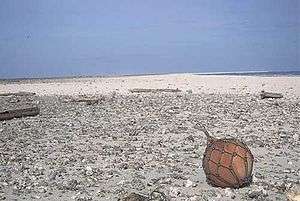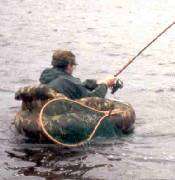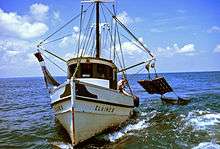Ghost net
Ghost nets are fishing nets that have been left or lost in the ocean by fishermen. These nets, often nearly invisible in the dim light, can be left tangled on a rocky reef or drifting in the open sea. They can entangle fish, dolphins, sea turtles, sharks, dugongs, crocodiles, seabirds, crabs, and other creatures, including the occasional human diver.[1] Acting as designed, the nets restrict movement, causing starvation, laceration and infection, and suffocation in those that need to return to the surface to breathe.[2]
.jpg)
Description

Some commercial fisherman use gillnets. These are suspended in the sea by flotation buoys, such as glass floats, along one edge. In this way they can form a vertical wall hundreds of metres long, where any fish within a certain size range can be caught. Normally these nets are collected by fishermen and the catch removed.
If this is not done, the net can continue to catch fish until the weight of the catch exceeds the buoyancy of the floats. The net then sinks, and the fish are devoured by bottom-dwelling crustaceans and other fish. Then the floats pull the net up again and the cycle continues. Given the high-quality synthetics that are used today, the destruction can continue for a long time.
The problem is not just nets but ghost gear in general;[3] old-fashioned crab traps, without the required "rot-out panel", also sit on the bottom, where they become self-baiting traps that go on catching crabs year after year. Even balled-up fishing line can be deadly for a variety of creatures, including birds and marine mammals.[4] Over time the nets become more and more tangled. In general, fish are less likely to be trapped in gear that has been down a long time.[5]
Fishermen sometimes abandon worn-out nets because it is often the easiest way to get rid of them.[3]
The French government offered a reward for ghost nets handed in to local coastguards along sections of the Normandy coast between 1980 and 1981. The project was abandoned when people vandalized nets to claim rewards, without retrieving anything at all from the shoreline or ocean.[6]
In September 2015, the Global Ghost Gear Initiative (GGGI) was created by the World Animal Protection to give a unique and stronger voice to the cause.
The term ALDFG means "abandoned or lost or discarded fishing gear".[4]
Environmental impact
From 2000 to 2012, the National Marine Fisheries Service reported an average of 11 large whales entangled in ghost nets every year along the US west coast. From 2002 to 2010, 870 nets were recovered in Washington (state) with over 32,000 marine animals trapped inside. Ghost gear is estimated to account for 10% (640,000 tonnes) of all marine litter.[3]
An estimated 46% of the Great Pacific garbage patch consists of fishing related plastics.[7]
According to the SeaDoc Society, each ghost net kills $20,000 worth of Dungeness crab over 10 years. The Virginia Institute of Marine Science calculated that ghost crab pots capture 1.25 million blue crabs each year in the Chesapeake Bay alone.[3]
In May 2016, the Australian Fisheries Management Authority (AFMA) recovered 10 tonnes of abandoned nets within the Australian Exclusive Economic Zone and Torres Strait protected zone perimeters. One protected turtle was rescued.[8]
Solutions
Alternative materials and practice
Unlike synthetic fishing nets, biodegradable fishing nets decompose naturally under water after a certain period of time. Coconut fibre (coir) fishing nets are commercially made and are hence a practical solution that can be taken by fishermen.[9][10]
Technology systems, for marking and tracking fishing gear, including GPS tracking, are being trailed to promote greater accountability and transparency.
Collection and recycling
Legalizing gear retrievals and establishing waste management systems is required to manage and mitigate abandoned, lost and discarded fishing gear at-sea.[4] The company Net-works worked out a solution to turn discarded fishing nets into carpet tiles.[11]
Since 2008, the US Fishing for Energy initiative collected 2.8 million pounds of fishing gear, and in partnership with Covanta Energy turned this into enough electricity to power 182 homes for one year by incineration.[3][12]
A plan to protect UK seas from ghost fishing was backed by the European Parliament Fisheries Committee in 2018. Mr. Flack, who led the committee, said: "Abandoned fishing nets are polluting our seas, wasting fishing stocks and indiscriminately killing whales, sea lions or even dolphins. The tragedy of ghost fishing must end.[13]
Net amnesty schemes such as Fishing for Litter incentivise the collection and responsible disposal of end of life fishing gear. These schemes address the root cause for many net abandonments which is the financial cost of their disposal.
Fishing nets are often made from extremely high quality plastics to ensure suitable strength, which makes them desirable for recycling. Initiatives like Healthy Seas are connecting environmental cleanup projects to manufacturers to re-use these materials. Brands such as Waterhaul and Econyl recycled waste nets into yarn and consumer products.
See also
- Drift netting
- Monofilament fishing line#Environmental impact
- The Derelict Crab Trap Program
- Plastic pollution
General:
Notes
- Esteban, Michelle (2002) Tracking Down Ghost Nets
- "'Ghost fishing' killing seabirds". BBC News. 28 June 2007. Retrieved 2008-04-01.
- Hannah Gould, Hidden problem of 'ghost gear': the abandoned fishing nets clogging up oceans, Theguardian.com, 10 September 2015
- Goodman, Alexa J.; Brillant, Sean; Walker, Tony R.; Bailey, Megan; Callaghan, Carolyn (August 2019). "A Ghostly Issue: Managing abandoned, lost and discarded lobster fishing gear in the Bay of Fundy in Eastern Canada". Ocean & Coastal Management: 104925. doi:10.1016/j.ocecoaman.2019.104925.
- Dunagan, Christopher (2000)The Sun. The net effect: trouble Archived 2009-04-04 at the Wayback Machine, 5 April
- Andres, Von Brandt (1984) Fish catching methods of the world ISBN 978-0-685-63409-7.
- Lebreton, L.; Slat, B.; Ferrari, F.; Sainte-Rose, B.; Aitken, J.; Marthouse, R.; Hajbane, S.; Cunsolo, S.; Schwarz, A.; Levivier, A.; Noble, K.; Debeljak, P.; Maral, H.; Schoeneich-Argent, R.; Brambini, R.; Reisser, J. (22 March 2018). "Evidence that the Great Pacific Garbage Patch is rapidly accumulating plastic". Scientific Reports. 8 (1): 4666. Bibcode:2018NatSR...8.4666L. doi:10.1038/s41598-018-22939-w. PMC 5864935. PMID 29568057.
- Ghost net busters, Afma.gov.au, 3 May 2016
- Biodegradable fishing nets: advantages
- Coir fishing nets
- Lynn Beavis,Net-Works is net gain for poor coastal community, Theguardian.com, 30 April 2015
- NOAA, Fishing for Energy. Accessed July 25, 2017
- MEPs back plan to end ‘ghost fishing', . 20 June, 2018
References
- Macfadyen G, Huntington T and Cappell R (2009) Abandoned, lost or otherwise discarded fishing gear FAO: Fisheries and Aquaculture, Technical paper 523. Rome.
.jpg)

